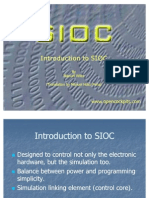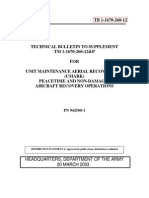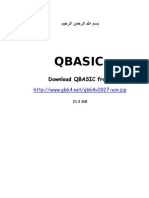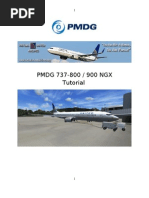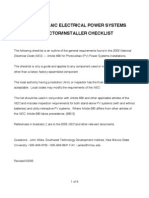CDU Tutorial Steps
CDU Tutorial Steps
Uploaded by
PabloSmithCopyright:
Available Formats
CDU Tutorial Steps
CDU Tutorial Steps
Uploaded by
PabloSmithOriginal Description:
Copyright
Available Formats
Share this document
Did you find this document useful?
Is this content inappropriate?
Copyright:
Available Formats
CDU Tutorial Steps
CDU Tutorial Steps
Uploaded by
PabloSmithCopyright:
Available Formats
CDU notation convention
MCP - MODE CONTROL PANE (panel de piloto automatico)
PFD - Primary Flight Display
CDU - Control Display Unit (FMC)
LSK 4L. 4th line select key from the top on the left side of the CDU
The space at the bottom of the CDU screen is called the scratchpad
PMDG 737NGX Tutorial #1
Press LSK 1L to select the FUEL page.
For this flight, were going to press the SET 1/3 prompt at LSK 5R.
Press RETURN at LSK 6L to get back to the root FS ACTIONS page.
Press LSK 2L to select the PAYLOAD page.
press the SET FULL > prompt at LSK 4R, and then enter 1500lbs (680 kg) into
each of the two cargo compartments by typing 1500 into the scratchpad and
then line selecting it into the LSK
FMC ROUTE SETUP
The route well be using from EGKK to EHAM is: CLN5P.CLN.UL620.REDFA.REDFA1A
This route consists of a Standard Instrument Departure (SID), an airway segment,
and a Standard Terminal Arrival Route (STAR).
In this case, were going to follow the Clacton Five Papa (CLN5P) SID to the
Clacton VOR (CLN) CLN acts as the interchange onto the 0.00.16UL620 airway.
We follow UL620 until the fix REDFA. REDFA is also the first waypoint of the
REDFA1A STAR into Amsterdam.
initializing the FMC lateral route on the CDU. The basic sequence well be following to
accomplish this is:
1. Position Initialization
2. Airport entry
3. Departure entry
4. Enroute entry
5. STAR and Approach entry
6. Route activation
POSITION INITIALIZATION:
Press MENU, which will back us out to the root menu.
Press LSK 1L, the <FMC prompt.
Press LSK 6R to move on to the POS INIT page
Go ahead though and enter EGKK into LSK 2L, the REF AIRPORT prompt just to
get you in the habit of doing it.
Press LSK 6R to select the RTE page
Youll notice that EGKK was alreadyplaced into the scratchpad for you. This is a
result of having entered it on the POS INIT page above.
PDMG Tutorial 1 - 28-ene-15
Line select the preloaded EGKK text into LSK 1L, the ORIGIN field.
Type EHAM into the scratchpad and line select it up with LSK 1R, the DEST field.
Type PMDG738 into the scratch pad and line select it with LSK 2R, the FLT NO.
Field
DEPARTURE ENTRY:
Press the DEP ARR button to get to the DEP ARR INDEX page
The DEP ARR INDEX page contains a series of prompts that take you to the
departure and arrival procedure selection pages for the two airports you entered
into the RTE page ORIGIN and DEST fields
Press LSK 1L to get to the EGKK DEPARTURES page
Press LSK 2R to select Runway 08R. Notice that several things happen when you
do this:
The runway is drawn on the ND.
The list of SIDs on the left side of the CDU screen is filtered so that only the SIDs
valid for Runway 08R are displayed.
Press LSK 2L to select the CLN5P SID. You will see a series of waypoints
representing the path of the SID appear on the ND with dashed blue lines
connecting them
ENROUTE ENTRY:
Press LSK 6R to get back to the RTE page
Press the NEXT PAGE button to get to RTE page 2
The VIA and TO columns on the left and right sides of the screen are what I was
referring to earlier with the highway analogy.
Note that if you were to just enter a single waypoint into the TO column, youd
see DIRECT automatically appear in the VIA column
Enter UL620 into the scratchpad and line select it into LSK 2L, the VIA columns
next empty line down.
Complete the airway segment by entering REDFA into the scratchpad and line
selecting it into LSK 2R, directly across from the UL620 entry.
STAR AND APPROACH ENTRY:
Press DEP ARR, then press LSK 2R to get to the EHAM ARRIVALS page.
Press NEXT PAGE three times and youll see that the runways are there on page 4
after you get through the three pages of approaches above them.
Press PREV PAGE once to return to page 3 and then select the REDFA1A STAR
located at LSK 1L.
The page now gets updated to show the approaches at the top with the other
STARs no longer showing
Press NEXT PAGE once and then select the ILS 18R at LSK 3R.
A list of transitions can appear below approaches as well as SIDs and STARs.
Press NEXT PAGE once and then select the SUG3B transition at LSK 4R.
The SUG3B is an approach transition normally used at night at Schiphol.
We now need to make a few slight modifications to the route before we activate it to
correct for navdata inaccuracies and to make sure the plane actually flies from the final
waypoint of the STAR, called SUGOL, onto the approach.
PDMG Tutorial 1 - 28-ene-15
Press the LEGS button
Press NEXT PAGE once to display LEGS page 2.
The waypoint REDFA at the bottom of the page has a 280/FL230B speed and
altitude restriction defined in the navdata that isnt there on the actual chart
Press the DEL (delete) key at the bottom of the CDU and then press LSK 5R to
remove the speed and altitude restriction at REDFA.
You should see dashes where the altitude was
Press NEXT PAGE again to display LEGS page 3.
There are two issues that need to be corrected on this page. these issues *do
not* exist if you are flying the tutorial with newer navdata past the 1108 cycle
Notice this sequence of waypoints on the page: SUGOL (VECTOR) SUGOL
Press LSK 4L next to the 2nd instance of the SUGOL waypoint
This copies the waypoint on that line into the scratch pad this copy contains
everything associated with that waypoint
Line select the copied SUGOL from the scratchpad to LSK 2L, overwriting the
other SUGOL thats there at that position
This operation results in the entire flightplan from the point of the copied SUGOL
on being pulled up to replace everything between it and the location it was line
selected to. This means that the first SUGOL and the (VECTOR) waypoints no
longerexist in the flight plan and weve now fixed the issue.
Type 250B/ into the scratchpad and press LSK 2R to enter it in.
This will allow the aircraft to cross SUGOL at any speed below 250 knots.
the chart specifies that the speed restriction at SUGOL is actually MAX 250 KTS
this is an at or below restriction, but the navdata has coded it as a hard or
mandatory 250 knot restriction
ROUTE ACTIVATION:
Press LSK 6R, the ACTIVATE > prompt
Were now telling the FMC that we want to commit to the route and activate it.
Youll notice that the light on the EXEC button is now lit up.
Press the EXEC (execute) button, which is now lit.
The route turns magenta on the ND and we now have a valid lateral route loaded
in the FMC
Notice however, that we have numerous blank entries on the right side of the
LEGS page there should be altitude and speed predictions here, but those wont
appear until we initialize the aircrafts performance in the next step
PERFORMANCE DATA AND VERTICAL PATH INITIALIZATION
Press INIT REF to proceed to the PERF INIT page
The PERF INIT page is where the crew tells the FMC what the aircrafts operating
weights are and set up parameters that affect the performance and vertical path
such as the Cost Index. This is also where the flights cruise altitude is set.
Click LSK 3L next to the empty ZFW field. Something close to 122.7 should appear in
the scratch pad. Click LSK 3L again to enter it into the ZFW field.
Enter 5.0 and line select it into the RESERVES field at LSK 4L
PDMG Tutorial 1 - 28-ene-15
Enter 25 and line select it into the COST INDEX field at LSK 5L.
Enter 6000 and line select it into the TRANS ALT field at LSK 5R.
Cost Index is a measure of how much the FMC values fuel economy vs. the overall
speed of the flight
Transition altitude is the altitude during the climb at which the FMC starts using
standard calibrated flight levels (altimeter set to 29.92 inHg or 1013 HPa) instead of
the actual QNH pressure altitude above sea level
Finally, enter 250 and line select it into the CRZ ALT field at LSK 1R.
This sets the cruise altitude for the flight. FL250 is standard for this short route
in real life.
Press the EXEC button to execute the performance data initialization.
Press the LEGS button you should now see predicted altitudes and speeds at any
waypoint that doesnt have preset restrictions coded into the procedure
N1 LIMIT AND TAKEOFF REFERENCE DATA SETUP
We now need to set the engine thrust rating for our takeoff and climb and enter our
takeoff data.
Press the N1 LIMIT button on the CDU to proceed to the N1 LIMIT page.
The N1 LIMIT page controls the thrust rating of the engines for takeoff and the
initial climb.
Press LSK 4L to select the TO-2 fixed derate mode
What were doing here is effectively turning our 26K engines into 22K engines for
the takeoff sequence.
Type 40 into the scratchpad and line select it into LSK 1L to enter an additional
assumed temperature of 40C on top of the fixed derate.
Entering the assumed temperature should have automatically selected the fixed CLB-1
derate too. If it didnt, press LSK 3R to select it.
Press LSK 6R to go to the TAKEOFF REF page
The TAKEOFF REF page contains several required entries for calculating the
aircrafts performance during the takeoff.
Enter 5 and line select it into the LSK 1L FLAPS field.
Click LSK 3L this is a similar shortcut to the ones for the GW and ZFW earlier on the PERF
INIT page. It will place the current CG value into the scratch pad for you.
Click LSKs 1R, 2R, and 3R this transfers the calculated takeoff V speeds from the FMCs
integrated QRH table onto the Primary Flight Display (PFD) speed tape.
COCKPIT CONFIGURATION
Set the takeoff trim on the pedestal to the left of the throttles to the value seen in LSK
3L from a few steps earlier. (5.04 in this case)
Set the FLAPS to 5. You can do this by pressing F7 three times or by left clicking three
times on the physical flap level in the VC.
Set the AUTOBRAKES knob to RTO by left clicking it once
PDMG Tutorial 1 - 28-ene-15
Pan up and set the MCP SPEED knob to V2, which should be around 143-145 knots,
again depending on your exact weight. Set it to whatever the TAKEOFF REF page
shows.
Set the MCP HEADING knob to the runway heading, which is 079 degrees at EGKK 08R.
Set the MCP ALTITUDE knob to 5000
Turn the captains and first officers FLIGHT DIRECTOR (FD) switches to their ON/UP
settings.
This allows the autopilots modes to arm and engage. Youll see a Green FD
annunciation on the PFD just above the artificial horizon when the switches are
on.
It is very important that BOTH flight director switches be on
Notice the green MA light below the captains FD switch as well this indicates
that the captains side FD is currently the master FD
Arm the AUTOTHROTTLE by clicking the switch on the MCP up into the ARM position.
Youll see a green light appear confirming that its on.
Arm the LNAV and VNAV modes by pressing the LNAV and VNAV buttons.
Youll see LNAV appear in small White letters at the bottom of the FMA roll mode
column and VNAV in the pitch mode column. LNAV will engage and turn green at
50 feet after you lift off and VNAV will engage at 400 feet.
Note for future reference that there are conditions where LNAV will not arm on
the ground, most notably if the first legs course is more than 5 degrees away
from the runway heading.
Before we go to the EFIS panel, pan over and back to the center pedestal, change to
the VC pedestal camera preset, or bring up the 2D version with Shift-4
right click the TRANSPONDERS TCAS mode selector four times until its fully to the
right in the TA/RA position.
Set the squawk code to 2200 (a standard IFR code you might be assigned by ATC in
real life) by right clicking the large knob on the left side of the unit once. (1200 is a
VFR code)
TA/RA sets the TCAS system to provide you with both traffic advisory and
resolution advisory messages. Tas simply alert you to the presence of traffic, RAs
give you commands to follow during a conflict to provide separation
Pan back up to the EFIS control panel to the left of the MCP
right click the outer portion of the BARO knob to set it from inches of mercury (inHg) to
hectopascals (hPa).
Since we have not changed the pressure for this flight, the standard setting of
1013 hPa should be already set at the lower right of the PFD
Similarly, press the inHg/hPa button on the Integrated Standby Flight Display (ISFD) to
set it to hectopascals as well.
Set the map display to 10nm by turning the EFIS control panel RANGE knob to the left
if its not already set.
Turn the traffic display on by clicking the TFC push button thats on the face of this
same knob.
Press the ENG button above the upper engine display unit (DU) twice to display the
compact secondary engine indications
PDMG Tutorial 1 - 28-ene-15
Press the DATA button thats located just below the EFIS range selector.
This adds labels below each waypoint on the ND that show you any entered
crossing altitudes as well as the predicted time you will pass over them
OVERHEAD SETUP:
Right click on an empty area and select the Cockpit\Overhead Lower Panel camera
view.
Turn the LANDING LIGHTS on by left clicking the gang-bar located above the switches
this will turn all four switches on with a single click.
Turn the NAVIGATION LIGHTS to the STROBE & STEADY (up) setting.
Turn the red ANTI-COLLISION light switch to the ON (down) setting.
Set both ENGINE START SELECTORS to CONT (continuous ignition).
Set the cruise altitude to 25000 and the landing altitude to 0 on the PRESSURIZATION
CONTROLLER
TAKEOFF:
Release the parking brake with Ctrl+. (period key)
Smoothly advance the thrust levers to 40% N1
Once stabilized at 40%, engage TO/GA mode. Clicking Left the hidden clickspot located
on the MCP just below the course knob.
Click the actual TOGA button on the thrust levers. This cause:
The autothrottle increases engine thrust to the takeoff N1 limit in our case, DTO 2 +40C , which will be around 88% N1
The flight director bars appear on the PFD
The flight mode annunciator (FMA) at the top of the PFD will show N1 in the
thrust field and TO/GA in the pitch field with VNAV armed below it
The roll field remains blank with LNAV armed in White below. Green boxes are
drawn for a few seconds around modes that have just engaged.
Maintain a small amount of forward pressure on your yoke or stick until reaching 80
upon reaching V1, we are committed to flying
When you reach VR, smoothly rotate at around 2 to 3 degrees per second toward a
goal of 15 degrees nose up after liftoff
ON AIR
Raise the landing gear by pressing G
Follow the flight directors command bars to maintain V2+20 knots
At 50 feet, LNAV will engage and turn green at the top of the FMA roll mode field.
Passing 400 feet (look at the radio altimeter readout at the bottom of the PFD) press
CMD A on the right side of the MCP to engage the autopilot.
Take your hands off the controls, the autopilot is now flying
deflecting the controls past a certain amount of force while the AP is engaged
will cause it to disconnect or drop into control wheel steering (CWS) mode
PDMG Tutorial 1 - 28-ene-15
Set the landing gear to the middle OFF position by left clicking the handle once
Right click the AUTOBRAKES knob to set it to the OFF position
Select the LEGS page on the captains CDU
Set the EFIS range selector to a larger range such as 20nm or 40nm for the departure
and climb.
At 1500 feet above ground level, the aircraft will reduce to climb thrust and begin
accelerating to 250 knots
Once we get near cruise, a setting of 80nm or even 160nm can be used to see
more of the route.
This is called acceleration height
Flap retraction on a normal flaps 5 takeoff and climbout is accomplished as follows
after reaching acceleration height:
At acceleration altitude select flaps 1.
Passing the 1 marker on the PFD speedtape, select flaps up.
Set the two ENGINE START SELECTORS at the front of the overhead to OFF
keep the MCP HEADING aligned with the aircrafts actual direction of flight when on a
leg of sufficient length rotating the heading knob to match the magenta course leg
The airplane will level off at 5000 feet due to the restrictions at TUNBY and DET.
SEGUIR CHEQUEOS A PARTRIR DE PAGINA 63 DEL PMDG-737NGX-Tutorial-1
PDMG Tutorial 1 - 28-ene-15
You might also like
- Warrior Engineering PaperDocument14 pagesWarrior Engineering PaperangusNo ratings yet
- Cswpa-Sheet MetalDocument2 pagesCswpa-Sheet MetaljabeNo ratings yet
- PMDG 737 Cold & Dark To Secure V2Document6 pagesPMDG 737 Cold & Dark To Secure V2Rodolfo WolffNo ratings yet
- CRJ900 Amm (71) AmmDocument2 pagesCRJ900 Amm (71) AmmN ANo ratings yet
- Engine Room Requisition 18.8.22Document139 pagesEngine Room Requisition 18.8.22Wisdom AMADINo ratings yet
- Eblg/Lgg: Liege, BelgiumDocument32 pagesEblg/Lgg: Liege, BelgiumTweed3A100% (1)
- A320 Checklist AvaDocument2 pagesA320 Checklist AvaAlejandroPuentes100% (2)
- Supplement Plane MakerDocument32 pagesSupplement Plane MakerCharlton EddieNo ratings yet
- Labor Production Table PDFDocument6 pagesLabor Production Table PDFFroilan EspinosaNo ratings yet
- Flight Management and NavigationDocument18 pagesFlight Management and NavigationmohamedNo ratings yet
- Ils Approach TutorialDocument6 pagesIls Approach TutorialRIYAN PUREWALNo ratings yet
- Annex 6 Part IIDocument20 pagesAnnex 6 Part IIDanielNo ratings yet
- A320 Procedures v0.7.6Document1 pageA320 Procedures v0.7.6DanielNo ratings yet
- FS2Crew Airbus Main OpsDocument43 pagesFS2Crew Airbus Main OpscarlosjricoNo ratings yet
- How To Live and Die in The Virtual Sky V0.2Document25 pagesHow To Live and Die in The Virtual Sky V0.2apexbangNo ratings yet
- Manual Sixpack Captain and First OfficerDocument1 pageManual Sixpack Captain and First OfficercrickdcricketNo ratings yet
- Tutorial C 130Document20 pagesTutorial C 130Julian Esteban CardenasNo ratings yet
- Self-Loading Cargo User ManualDocument59 pagesSelf-Loading Cargo User ManualanuarNo ratings yet
- Autoit Brief Information and Cheat Sheet: Installation HintsDocument2 pagesAutoit Brief Information and Cheat Sheet: Installation HintsClemente Albañil XalateNo ratings yet
- A320 ChecklistDocument1 pageA320 Checklistdokinmars2144No ratings yet
- Army Aviation Digest - Jan 1993Document68 pagesArmy Aviation Digest - Jan 1993Aviation/Space History LibraryNo ratings yet
- ATR72Document21 pagesATR72rsookramNo ratings yet
- 737ng Manual AFDS Module AFD1075Document1 page737ng Manual AFDS Module AFD1075crickdcricketNo ratings yet
- A320 ChecklistDocument1 pageA320 Checklistmaj-380No ratings yet
- FALCON 4.0 Quick Threat GuideDocument6 pagesFALCON 4.0 Quick Threat GuideDraggon FN100% (1)
- A310 / A300-600 Course Notes Manual 34 - NavigationDocument50 pagesA310 / A300-600 Course Notes Manual 34 - NavigationPaul John BalbuenaNo ratings yet
- SIOC PresentationDocument67 pagesSIOC PresentationIon SurduNo ratings yet
- A320Document1 pageA320pilotmo0% (1)
- Flight Simulation ReportDocument6 pagesFlight Simulation Reportlikith333No ratings yet
- AS350 B2 - IntroDocument25 pagesAS350 B2 - IntroEX919No ratings yet
- Opencockpits Overhead MapeadoIO IOmappingDocument4 pagesOpencockpits Overhead MapeadoIO IOmappingImanolLopezNo ratings yet
- FS2Crew ATR Main OpsDocument73 pagesFS2Crew ATR Main Opsstilllife87No ratings yet
- User Manual PA A320 FD Special Version V3 PDFDocument59 pagesUser Manual PA A320 FD Special Version V3 PDFaviation310300100% (1)
- TB 1-1670-260-12Document19 pagesTB 1-1670-260-12"Rufus"No ratings yet
- ATR72-500 GPWS Graphic RequestsDocument9 pagesATR72-500 GPWS Graphic RequestsEdwin BarreraNo ratings yet
- Bird Strike RPDocument14 pagesBird Strike RPtbNo ratings yet
- MD 82 X Plane Engine Starting 103Document29 pagesMD 82 X Plane Engine Starting 103Uslher Román GasparNo ratings yet
- Bb560 CalypsoDocument48 pagesBb560 CalypsoMunteanuCNo ratings yet
- Welcome To The Airbus A380 Basic Manual For Virtual Air Cadet AirlinesDocument6 pagesWelcome To The Airbus A380 Basic Manual For Virtual Air Cadet AirlinesCamilo Andres Martinez AldayaNo ratings yet
- Continuous Descent Final ApproachDocument5 pagesContinuous Descent Final ApproachJehan IchhaporiaNo ratings yet
- Aerosoft Airbus A320 A321 Vol6 StepbyStep enDocument124 pagesAerosoft Airbus A320 A321 Vol6 StepbyStep envitor_carneiroNo ratings yet
- A320X Parking StanedDocument11 pagesA320X Parking StanedchaituNo ratings yet
- 01-Fiches Atr600 enDocument4 pages01-Fiches Atr600 enLg123_4No ratings yet
- 1.1. ATIS 1.2. Rwy Operations 11.. Ggeenneerraall: 1.2.1. Preferential Rwy System 1.2.2. RWY USAGEDocument30 pages1.1. ATIS 1.2. Rwy Operations 11.. Ggeenneerraall: 1.2.1. Preferential Rwy System 1.2.2. RWY USAGEDiego PauloNo ratings yet
- Cabin PressurizationDocument8 pagesCabin PressurizationmanowarNo ratings yet
- ASW22 BLV 2Document20 pagesASW22 BLV 2Rene QueirozNo ratings yet
- Checklist B747 PMDGDocument11 pagesChecklist B747 PMDGMohamed AbdelazimNo ratings yet
- MD11 QREF CHECKLIST Rotate MD-11 v1.3Document8 pagesMD11 QREF CHECKLIST Rotate MD-11 v1.3kakawatoxperezNo ratings yet
- X-Plane Helicopter ManualDocument22 pagesX-Plane Helicopter ManualErnani KernNo ratings yet
- Easa Regulat Struct Diag 2024.02.20 - Incl LinksDocument1 pageEasa Regulat Struct Diag 2024.02.20 - Incl Linksalsaidiamjad28No ratings yet
- Quick BasicDocument34 pagesQuick BasicMohamad SaadNo ratings yet
- FS2004 - The Aircraft - CFG FileDocument5 pagesFS2004 - The Aircraft - CFG FiletumbNo ratings yet
- A320 Memory ItemsDocument1 pageA320 Memory ItemsMaalu ManoharNo ratings yet
- How To Program The PMDG 737 NGX FMC: Greg Whiley (Captaus) Aussie Star Flight SimulationDocument14 pagesHow To Program The PMDG 737 NGX FMC: Greg Whiley (Captaus) Aussie Star Flight SimulationDarek CzarneckiNo ratings yet
- Airbus MCDUDocument10 pagesAirbus MCDUMabrouka LinuxNo ratings yet
- CoolSky Super 80 Professional FMC FlightDocument19 pagesCoolSky Super 80 Professional FMC FlightpitifritiNo ratings yet
- Embraer E175 by X Crafts FMS Demo FlightDocument2 pagesEmbraer E175 by X Crafts FMS Demo FlightOmer VarolNo ratings yet
- Addendum Addendum: Add-On FürDocument18 pagesAddendum Addendum: Add-On FürBoba FettNo ratings yet
- Manual - AproximaçãoDocument5 pagesManual - AproximaçãoJCarlos_e_GrazyNo ratings yet
- T-44C FMS GuideDocument143 pagesT-44C FMS GuideTrung Dung100% (1)
- 737NXG Dark and Cold TutorialDocument30 pages737NXG Dark and Cold Tutorialdebilbo2100% (3)
- Embraer EJets Checklist xp12Document7 pagesEmbraer EJets Checklist xp12rajsamochodowy. plNo ratings yet
- 06 - Conditional ProceduresDocument72 pages06 - Conditional ProceduresNull RFFRNo ratings yet
- Virgin Coconut Oil: Process FlowDocument1 pageVirgin Coconut Oil: Process FlowJah de DiosNo ratings yet
- Retail TechnopakDocument63 pagesRetail TechnopakVivek BeheraNo ratings yet
- Tables For Processing GcodesDocument33 pagesTables For Processing Gcodesandreeaoana45No ratings yet
- Compact Orifice Flow Meter: Features & BenefitsDocument2 pagesCompact Orifice Flow Meter: Features & Benefitsmohan babuNo ratings yet
- Is-En - Iec 61400-1-2005Document18 pagesIs-En - Iec 61400-1-2005coolkaisyNo ratings yet
- Fire Alarm 01-23 NewDocument23 pagesFire Alarm 01-23 NewVenkatesh VenkateshNo ratings yet
- Final Exam - CS 2203 Databases 1Document12 pagesFinal Exam - CS 2203 Databases 1Abdul AzizNo ratings yet
- Method of Statement Room Integrity TestDocument3 pagesMethod of Statement Room Integrity TestManesh KariyadanNo ratings yet
- 10th Computer Science Exercises ProgramsDocument18 pages10th Computer Science Exercises ProgramsAditya Kumar100% (1)
- PV Check ListDocument6 pagesPV Check Listvijayasiva86100% (1)
- Dosificador Electromagnetico Seko Apg 803Document8 pagesDosificador Electromagnetico Seko Apg 803Niko OlnicasaNo ratings yet
- Topcon Gt - Instruction Manual English (1)Document180 pagesTopcon Gt - Instruction Manual English (1)Munzir UsmanNo ratings yet
- FCI Advt 2015 PDFDocument24 pagesFCI Advt 2015 PDFAnkit GhildiyalNo ratings yet
- 0 Dumpacore 3rd Com - Samsung.android - App.contactsDocument53 pages0 Dumpacore 3rd Com - Samsung.android - App.contactsRuben CotaNo ratings yet
- Unit 1 AVE ENGINEERINGDocument28 pagesUnit 1 AVE ENGINEERINGShannon ClarkNo ratings yet
- Solar ThermalDocument14 pagesSolar ThermalSiddharth ShahNo ratings yet
- The Routing TableDocument6 pagesThe Routing TableRahul ShrivastavaNo ratings yet
- TCDocument34 pagesTCmaria jose carrion ramosNo ratings yet
- Note For B. E. 2 Semester Students: Mess FeeDocument1 pageNote For B. E. 2 Semester Students: Mess FeeSushant KhattarNo ratings yet
- Volatile Test-Full ReportDocument7 pagesVolatile Test-Full ReportSamuelNo ratings yet
- Specification For Instrument CablesDocument39 pagesSpecification For Instrument CablesSellappan Muthusamy100% (2)
- Sad - Moke TestDocument13 pagesSad - Moke Testperfect_onkarNo ratings yet
- LogDocument648 pagesLogDziban AliXII AN 2No ratings yet
- Knowledge Creation - and Management New Challenges For ManagersDocument364 pagesKnowledge Creation - and Management New Challenges For ManagersDeelstra Evert JanNo ratings yet
- Venkatraman ResumeDocument2 pagesVenkatraman Resumevenkatraman MuthukrishnanNo ratings yet
- Install AdminDocument304 pagesInstall AdminRaghavendraYadavNo ratings yet
- tmp4F9A TMPDocument8 pagestmp4F9A TMPFrontiersNo ratings yet


























